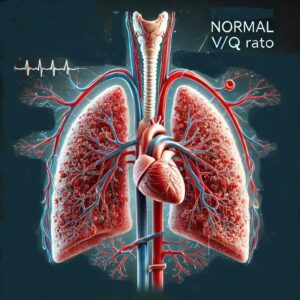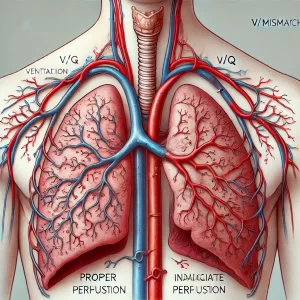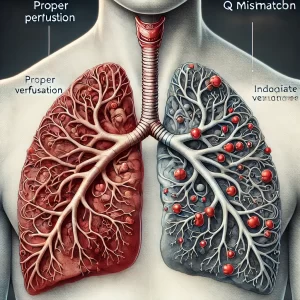In the field of Critical Care, the ventilation/perfusion (V/Q) ratio is a fundamental concept that reflects the efficiency and effectiveness of gas exchange in the lungs. This ratio is crucial for ensuring adequate oxygenation of blood and removal of carbon dioxide from the body. In this article, we will delve into the normal V/Q ratio, how it is calculated, and the implications of V/Q mismatch from the perspectives of both ventilation (V) and perfusion (Q).
The Normal V/Q Ratio
The V/Q ratio is the relationship between the amount of air reaching the alveoli (ventilation, V) and the blood reaching the alveoli (perfusion, Q). The normal V/Q ratio is approximately 0.8, meaning that for every 1 liter of blood reaching the lungs, about 0.8 liters of air is supplied. This ratio ensures optimal gas exchange, where oxygen is efficiently absorbed into the blood and carbon dioxide is expelled from it.

Calculation of V/Q Ratio
To understand the V/Q ratio, let’s break down its components:
- Ventilation (V): The volume of air entering the alveoli per minute. In a healthy adult, this is about 4 liters per minute.
- Perfusion (Q): The volume of blood reaching the alveoli per minute. This is approximately 5 liters per minute in a healthy adult.
The V/Q ratio is calculated as follows: V/Q Ratio = Ventilation (V)/Perfusion (Q)
Using the normal values: V/Q Ratio = 4 liters of air per minute/5 liters of blood per minute = 0.8
V/Q Mismatch: Ventilation and Perfusion
A V/Q mismatch occurs when there is an imbalance between ventilation and perfusion, leading to inadequate gas exchange. This can result from issues with either ventilation (V) or perfusion (Q).
Ventilation (V) Issues
When the V/Q ratio is altered due to changes in ventilation, the following scenarios can occur:
- High V/Q Ratio: This occurs when ventilation exceeds perfusion. Causes include:
- Pulmonary Embolism: A blockage in a pulmonary artery reduces blood flow to the alveoli, resulting in areas of the lung being well-ventilated but poorly perfused.
- Emphysema: Damage to alveoli reduces surface area for gas exchange, causing well-ventilated but poorly perfused regions.
- Low V/Q Ratio: This occurs when ventilation is less than perfusion. Causes include:
- Chronic Obstructive Pulmonary Disease (COPD): Airflow obstruction leads to poorly ventilated but well-perfused alveoli.
- Asthma: Constriction of airways limits ventilation, causing a mismatch.
Perfusion (Q) Issues
When the V/Q ratio is altered due to changes in perfusion, the following scenarios can occur:
- High V/Q Ratio: As mentioned earlier, a high V/Q ratio often results from reduced perfusion. Conditions such as pulmonary embolism or systemic hypotension can cause this imbalance.
- Low V/Q Ratio: This results from increased perfusion relative to ventilation. Conditions that can cause this include:
- Pulmonary Edema: Fluid in the alveoli reduces ventilation while perfusion remains unchanged or increases.
- Pneumonia: Infection leads to alveolar filling with fluid or pus, impairing ventilation while perfusion is unaffected.


Perfusion Issue Ventilation Issue
Clinical Implications and Management
Understanding V/Q mismatch is crucial for diagnosing and managing respiratory conditions. In clinical practice, healthcare professionals use various diagnostic tools, such as arterial blood gases (ABGs), pulse oximetry, and imaging studies, to assess V/Q status.
Treatment Strategies
- Addressing High V/Q Ratio:
- Pulmonary Embolism: Anticoagulation therapy to dissolve clots.
- Emphysema: Bronchodilators, steroids, and supplemental oxygen.
- Addressing Low V/Q Ratio:
- COPD and Asthma: Bronchodilators, anti-inflammatory medications, and pulmonary rehabilitation.
- Pulmonary Edema and Pneumonia: Diuretics for edema and antibiotics for pneumonia, along with supportive care.
Advanced Interventions
In severe cases, advanced interventions such as mechanical ventilation, extracorporeal membrane oxygenation (ECMO), or surgical procedures may be necessary to correct the V/Q imbalance and ensure adequate oxygenation and ventilation.
Conclusion
The V/Q ratio is a vital concept in respiratory care, representing the balance between ventilation and perfusion necessary for effective gas exchange. Understanding the causes and consequences of V/Q mismatch enables healthcare professionals to diagnose, treat, and manage various respiratory conditions effectively. By maintaining this delicate balance, we can ensure better outcomes for patients with respiratory disorders.
Stay informed and stay proactive in monitoring and managing V/Q ratios in your clinical practice to provide the best possible care for your patients.




